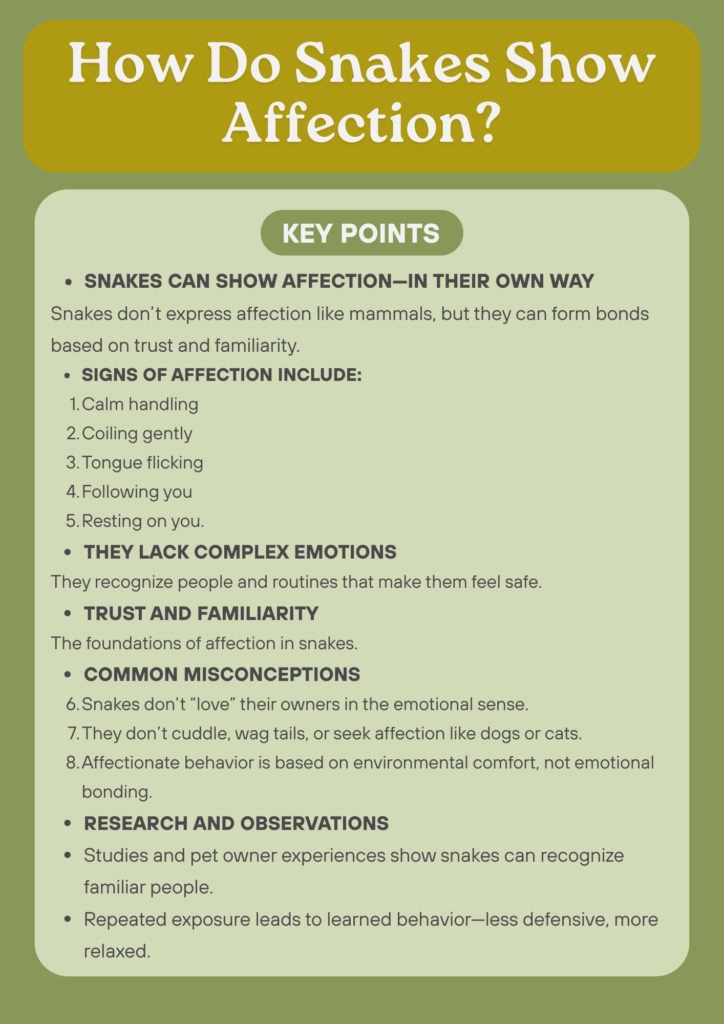When people think of snakes, affection is probably not the first thing that comes to mind. After all, they’re often portrayed as cold, calculating creatures. But what if I told you that snakes actually can show affection? Yep, you read that right. Snakes, despite their reputation, are capable of bonding with their owners, showing affection in subtle yet meaningful ways.
This may sound surprising, but there’s a growing body of research and anecdotal evidence suggesting that these slithery creatures do indeed form attachments and can express affection, though not in the same way as, say, a dog or cat.
If you’re a snake lover—or thinking about getting a snake as a pet—understanding how snakes show affection could enhance your relationship with them. Let’s dive deeper into the slithery world of snake behavior and explore how these fascinating reptiles express love (or whatever you might call it).
Table of Contents
Do Snakes Feel Affection?
Before we jump into how snakes show affection, it’s essential to first address the big question: Do they even feel affection? Well, snakes aren’t exactly cuddly creatures, and they don’t display affection the way mammals do, especially not with wagging tails or purring. That said, there’s evidence that some snakes can recognize and bond with their owners. They don’t have the brain structure for complex emotions like humans or dogs, but they can form positive associations with people, environments, and routines.
Snakes primarily operate on instincts and natural behaviors—like hunting, mating, and surviving—but they are also capable of learning and adapting to their surroundings. Over time, a snake may begin to trust its owner, becoming more comfortable and less stressed around them. This trust could be considered a type of affection, though it’s quite different from what we see in mammals.

How Do Snakes Show Affection? It’s All About the Signs
So, how exactly do snakes show affection? You might be surprised to learn that it’s not all that different from the way other animals express comfort or familiarity. While snakes won’t jump into your lap or curl up next to you on the couch (sorry, snake cuddles just aren’t a thing), they have unique ways of communicating their comfort and trust. Let’s explore some of these behaviors:
1. Following You Around
One of the most common signs that a snake feels a connection with its owner is that it will start to follow you around. If you have a pet snake, you’ve probably noticed that it seems to pay attention to where you go. This behavior suggests that your snake is aware of your presence and feels comfortable enough to engage with you. Snakes don’t have an acute sense of sight (except for some species), so they rely on other senses like heat and scent to detect you. If your snake is actively moving toward you, it’s likely recognizing you as a source of comfort or security.
2. Calm Behavior During Handling
A snake that trusts its owner will usually remain calm and docile when handled. If you’re new to snake care, you might think that any sudden movement or touch will send your snake into a defensive strike mode. But a snake that’s bonded with its owner will typically stay relaxed during handling, even allowing you to gently stroke its body. This behavior is a strong indicator that the snake feels safe with you and that you’re not a threat. The absence of defensive hissing or striking is one of the most obvious signs of affection in snakes.
3. Sniffing and Tasting
If you notice your snake repeatedly flicking its tongue at you or in your direction, it’s a sign that it’s trying to gather information about you. This is totally normal snake behavior, as they use their forked tongues to “smell” the environment around them. When snakes seem to “taste” the air more than usual around you, it can indicate curiosity or familiarity. This behavior is often seen when the snake is comfortable and not in a state of stress, which means it could be a subtle form of affection.
4. Coiling Around You (In a Non-Threatening Way)
While it’s true that snakes coil around things, like branches or objects in their environment, some snakes will also coil gently around their owners. This isn’t a sign of aggression, but more like a way of showing that they feel secure in your presence. It’s kind of like when a cat curls up beside you or a dog leans on you—it’s a way of staying close. Of course, this varies by species and individual temperament, but some snakes will actively seek to coil around their handler’s arms or body when being held.
5. Resting on You
Another sign of affection in snakes is when they choose to rest on you or near you. If you’ve ever spent time with your snake outside of its enclosure, you might have noticed that it seems to seek you out for comfort. Some snakes will simply rest on their owner’s lap, shoulders, or arms, showing trust in their presence. This is not typical behavior for wild snakes, but pet snakes that are familiar with their owners may exhibit this kind of affectionate behavior.
Why Do Snakes Show Affection?
You might be wondering, “Why would a snake feel affection at all?” After all, snakes don’t have the same emotional needs as mammals, right? Well, the answer lies in their survival instincts. Snakes, like many reptiles, are more likely to engage with their environment and those in it if they feel secure. If your snake shows signs of comfort and trust around you, it’s likely because it associates you with positive experiences, like feeding, warmth, and safety. Over time, the snake learns that you’re not a threat and may become more relaxed in your presence, which could be interpreted as affection.
Also, some species of snakes—like ball pythons, corn snakes, and boas—are known for their more docile, social natures. They have the capacity for repeated interactions with humans, which may help strengthen the bond over time. For these types of snakes, affection is a byproduct of familiarity and mutual trust.
How to Foster Affection in Your Snake
If you’re hoping to build a stronger bond with your pet snake, here are a few tips:
- Be Consistent: Snakes thrive on routine. By feeding them on a regular schedule and gently handling them regularly, you can help your snake feel more comfortable and secure in your presence.
- Handle Gently: Be patient and gentle when handling your snake. Avoid jerky movements, and always support their body so they feel safe and secure.
- Provide a Comfortable Environment: Make sure your snake’s habitat is comfortable, with proper temperature, humidity, and hiding places. A snake that feels at ease in its environment will be more likely to show affection toward you.
- Respect Their Space: Not all snakes will enjoy constant interaction. If your snake isn’t responding to you in an affectionate way, it could be a sign that it needs space. Always respect your snake’s boundaries.
Final Thoughts
Snakes may not show affection the way our cuddly pets do, but that doesn’t mean they can’t form bonds with their owners. Understanding the subtle signs of affection—like following you, coiling gently, or staying calm during handling—can help you build a trusting relationship with your snake. While their way of expressing affection may not involve tail-wagging or purring, it’s clear that these fascinating creatures can develop a bond with their human companions. So, the next time you’re with your snake, take a moment to appreciate the unique way it shows its trust and affection—you might just see your snake in a whole new light!

